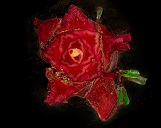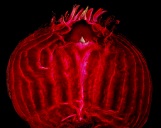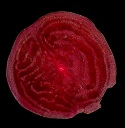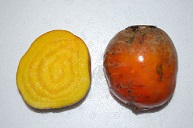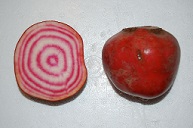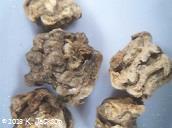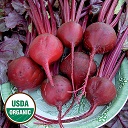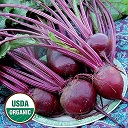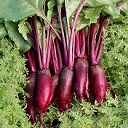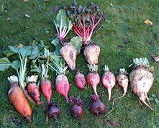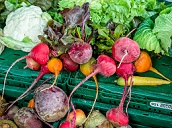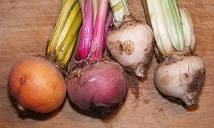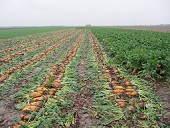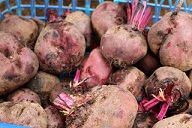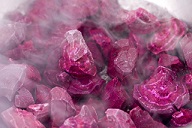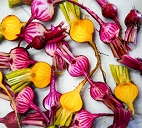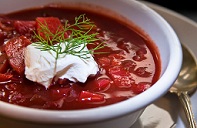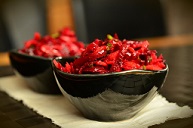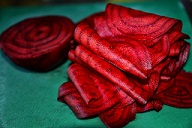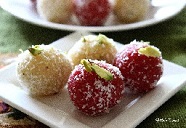| Beet, Beta vulgaris | ||||||||||||||||||||||||||||||||||||||||||||||||||
|---|---|---|---|---|---|---|---|---|---|---|---|---|---|---|---|---|---|---|---|---|---|---|---|---|---|---|---|---|---|---|---|---|---|---|---|---|---|---|---|---|---|---|---|---|---|---|---|---|---|---|
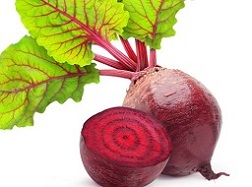 Fig. 1  Beta vulgaris 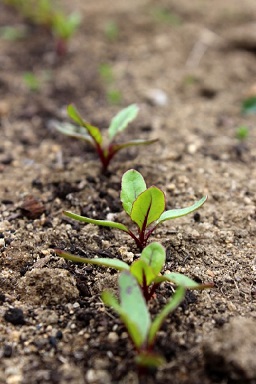 Fig. 2  Semis de betteraves rouges (beetroot seedlings) 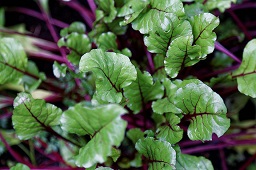 Fig. 3  Beetroot Bettolo F1 hybrid, Capel Manor College and Gardens, England 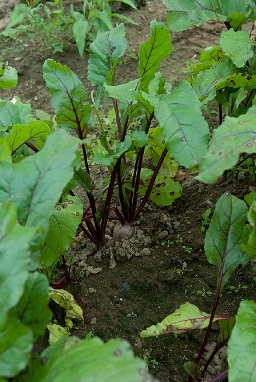 Fig. 4  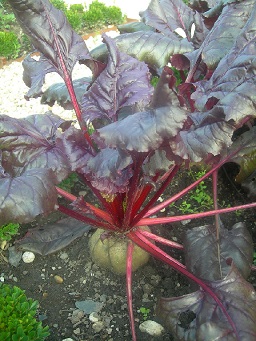 Fig. 5  B. vulgaris subsp. vulgaris var. ruba 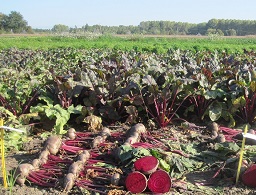 Fig. 6  Beetroot fields 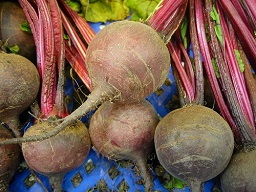 Fig. 7  Red beet (B. vulgaris), Sweden 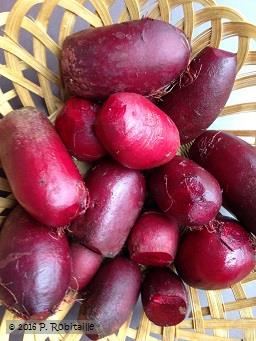 Fig. 13  Home grown B. vulgaris var. cylindra 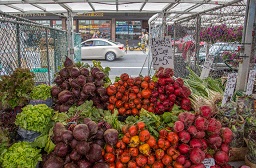 Fig. 14  ByWard Market Beets. Ottawa, Canada 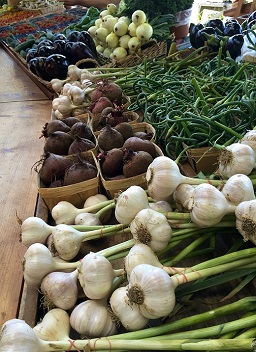 Fig. 15  Beets at market 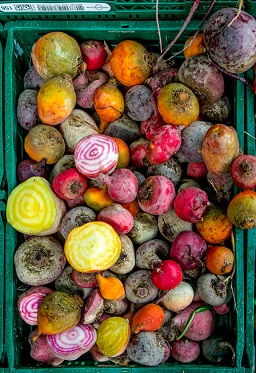 Fig. 25  Beetroot of all colours, Freiburg, Germany 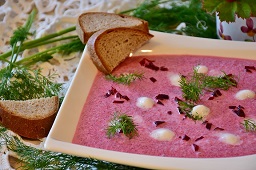 Fig. 28  Beetroot soup  Fig. 29  Carob beetroot vegan cake with agar bunnies 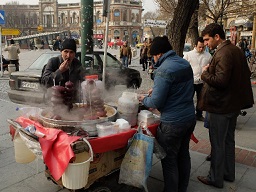 Fig. 38  Street food in Tehran: boiled beetroot | Scientific
name Beta vulgaris (Garden Beet Group or Beetroot Group) Common names English: Beet, beetroot, garden beet, red beet, redroot, table beet; Czech: salátová řepa, červená řepa; Danish: rødbede; Dutch: rode beetwortel, rode biet; French: betterave potagère, betterave rouge à salade; German: rote Bete, rote Rübe; Hungarian, cékla; Italian: barbabietola d'insalata, barbietola da orto; Romanian: sfeclă; Russian: cвекла столовая; Slovak: repa červená; Slovene: rdeča pesa; Spanish: remolacha colorada, remolacha hortelana; Spanish (HN): betabel; Swedish: rödbeta 4 Synonyms B. maritima L.; B. vulgaris L. spp. maritima (L.) Arcang. 3 Relatives Leaf beet group (swiss chard and beet spinach); sugar beet group; fodderbeet group or mangelwurzel; wild sea beet (B. vulgaris var. maritima) Family Chenopodiaceae (goosefoot) USDA hardiness zones 2 - 11 Uses Food, beverage, food dye, medicinal, fodder, decorative: edible landscape Height Leafy stems 3-6.5 ft (1-2 m) tall 6 Life cycle Annual: root, leaves; biennial: seeds Flowers Bisexual or hermaphrodite, 0.12-0.2 in. (3-5 mm) diameter, green or tinged reddish, five petals, on dense spikes (inflorescence) 3-4 ft (1-1.2 m) tall 13,6 Cold requirement for seed production 39-50 °F (3.9-10 °C) for 2 weeks to induce flowering 11 Seed Season Cool season Days to harvest 55 to 90 days 14 Soil tolerance Tolerates low fertility; well-drained, loose 1 pH preference Slightly acidic 6.8–6.0 2 Spacing Plant: 2-4 in., row: 12 in. 5 Plants per 10ft 30-60 5 Yield per 10 ft 7.5 pounds 5 USDA Nutrient Content: raw, cooked, greens raw pdf Light requirement/photoperiod Full sun, part shade; long day (>14 hours) 14 Water requirement Requires consistent supply Soil salt tolerance Medium (4-10 dS/m) 14 Cold tolerance Beets will tolerate frosts and mild freezes 11 Invasive potential * None known Known hazard The consumption of beets causes pink or red urine, beeturia (betacyaninuria), in some people 13,6 Reading Material Beet and Swiss Chard Production in California, University of California pdf Beta vulgaris L., Handbook Of Energy Crops Origin Beets are thought to have been developed from the seabeet (Beta maritima), which is native to southern Europe. They have been cultivated since at least the third century A.D. and were fully developed as agronomic crops in the nineteenth century by German and French breeders. 11 Eastern and Central Europe has historically been associated with the large-scale cultivation of maincrop beetroot. The major beetroot producers today are Russia, Poland, France, Italy and the USA. Northern Europe and North America produce the bulk of the commercial crop ... In most other areas, beetroot is mainly grown in market gardens or for home consumption. 13 Sorting Beta names, Multilingual Multiscript Plant Name Database, University of Melbourne, Australia ext. link Description Beets may be grown for both their greens and their roots. They are heavy yielders and high in iron and vitamins. Beets come in several colors and shapes. In addition to the standard dark red, orange and white varieties are available. The lighter varieties do not bleed their color as readily, but are less attractive in canning jars and on the plate than the red ones. Round beets are most common, but flat and oblong types are grown as well. Flat and round beets tend to be early maturing varieties, while the long cylindrical beets are usually late maturing. 7 Distinct light and dark rings are usually visible when beetroot is cut transversely. This is due to different amounts of pigment in the vascular system and storage tissue of the root. The vascular system appears as darker bands due to higher levels of pigment, while the storage tissue appears as lighter bands. In some deep red cultivars like Boltardy and Red Ace this colour difference can be quite subtle. The colour difference is at its most obvious in Chioggia, with its concentric bullseye pattern of rosy red bands (vascular system) and white bands (storage tissue). 13
Fig. 8,9,10. B. vulgaris subsp. vulgaris. Beet root cross section. Fig. 11. A yellow garden beetroot. Fig. 12. 'Chioggia' beetroot, showing alternate tissue layers in white and pink. A traditional cultivar in the Venice region. Flowers Beets produce an enlarged root then at the end of the first year a cooling period, vernalization, is needed before it will produce flowers during the second year. 14 days at 35-50 °F (2-10 °C) should work. The flowers are typically small, greenish to yellow, growing in small clusters on slender spikes, with a 5-parted calyx that lacks petals. They are wind pollinated. 6 Pollination Beetroot is self-incompatible and will not self-fertilize. Therefore, blocks or rows of beetroot of the same cultivar are necessary to produce seed. ... Beta vulgaris flowers produce nectar and are visited by insects. 13 It is generally accepted that pollen of Beta vulgaris is wind-borne over relatively long distances and sufficient isolation should therefore be ensured. Most authorities stipulate isolation distances of at least 500 m (1,640 ft) between cultivars of the same type (e.g. red globe) and at least 1000 m (3,280 ft) between different types of cultivar (e.g. between red globe and cylindrical types). Beetroot is cross-compatible with the other subspecies of Beta vulgaris (i.e. sugar beet, mangolds, spinach beet and Swiss chard) 12 In gardens, where large isolation distances are often not possible when seed saving for personal use, horticultural fleece can be used to isolate blocks of flowering plants to help reduce cross-fertilization. 13 The fruit often develops from aggregates of two or more flowers joined at their bases. 6
Fig. 16. Flower stalk. B. vulgaris subsp. vulgaris var. conditiva Fig. 18. Seeds, microscope image Cultivars Some of the best recommended for Florida are Asgrow Wonder, Bull's Blood (tops), Early Wonder (Fig. 19), Cylindra, Detroit Dark Red, Golden Beets (yellow), Green Top, Pacemaker III, Red Ace. 1,2 Beets grown for processing are usually cylindrical in shape. Cylindrical beets offer greater uniformity and efficiency for sliced beet production, a major requirement for processors. Nonhybrids: Detroit Short Top, Ruby Ball, and Scarlet Supreme. Hybrid: Red Ace F1 (Cercospora - tolerant). Hybrid beets have the advantage of greater seedling vigor and improved top growth and resistance to certain diseases such as Cercospora. On the negative side, the vigor of hybrid beets may result in beet roots going “out of grade” ... more quickly if harvest is delayed by poor weather or other reasons. Table beets are also known as fresh-market beets. Red, round types: Detroit Stains, Ruby Queen (bulbs well when crowded). Hybrids: Red Ace F1, Hybrid Pacemaker III. For trial: Avenger F1, Big Red, Ivax (monogerm), Warrior F1. Bunching: Crosby’s Greentop, Winter Keeper (long-season, for late-fall gardening use). Some beets have unusual colors or shapes; these are known as novelty beets. Red elongated: Cylindra, Forono (half-long). Alternating red and white: Chiaggia. Yellow, round: Burpee Golden. Yellow elongated: Burpee Golden. White, round: Showhite, Albino. Most cylindrical varieties produce beets with an “earthy” taste, which has limited their adoption. Spinach beets (Beta vulgaris orientalis group) are table beets grown for their succulent leaves, which can be harvested over an extended period. The main variety is Burpee Red Ball. 11
Fig. 19. Beet Bull's Bood Fig. 20. Detroit Dark Red Fig. 21. Cylindra Fig. 22. Different types of B. vulgaris grown: beet, swiss chard, sugar beet, animal fodder Fig. 23. Beetroot of all colours, Freiburg, Germany Fig. 24. Uncommon beetroot colours. Yellow, white and pink/white striped beetroot (visible when sliced). Harvesting Greens may be harvested when of sufficient size. Excessive removal of the leaves for greens will inhibit enlarging of the root. Harvest greens lightly until beet is ready for harvest at 1 to 3 inches in diameter. Roots larger than 3 inches tend to be woody. 7 Table beets generally reach market size in 42 to 56 days; round beets require 60 to 70 days. Cylindrical beets for processing require 70 to 80 days, depending on planting date, sizes desired, and growth season. 11 The roots can be harvested over a period of time, to give beets ranging in size from small to large and mature ... The leaves start to fall away from an upright position when beets reach maturity. Beetroot must be lifted carefully, because bruised and broken roots bleed and are of diminished culinary value ... The leaves are traditionally twisted off above the crown. If the leaves are not wanted in the kitchen, their high mineral content (e.g. magnesium) makes them a useful addition to the compost heap. Small beets or minibeets (below 5 cm) may be harvested about two months after sowing, while mature full-size beets may be harvested after three months or longer. Final root size is due to variety and spacing, and not degree of maturity. 13
Fig. 26. B. vulgaris, Beetroot fields, Germany Fig. 27. Nigerian Beetroot, Abuja, Nigeria Storage Beet roots should be reasonably dry and free of soil for best storage; they should also be topped and sorted to remove all those with disease or mechanical injury ... Beets should be stored at 32 °F (0 °C) and relative humidity of 98 to 100 percent ... Like other root crops, beets are well adapted to storage. Topped beets stored at 32 °F (0 °C) can be expected to keep 4 to 6 months under suitable storage conditions. Bunched beets are much more perishable than topped beets, but they can be stored at 32 °F (0 °C) for 10 to 14 days. Storing them in crushed ice will help keep the bunched beets cold, especially if refrigeration is not available. 11 Propagation by seed Small hard, irregularly shaped “seed” with a woody calyx. 6 The beet seed is actually a fruit with one to four seeds enclosed. ... Crushing them lightly with a rolling pin will allow individual seed to separate and reduce the amount of thinning required. 7 Seed storage 2-4 years Sowing season North: Aug–Feb, central: Sept–Feb, south: Oct–Jan 5 Sow seed every 2 or 3 weeks for a continuous supply. 11 Days to maturity 45-80 days 7 Sowing depth ½ –1 inch 5 Best growth temperature 50 °F to 64 °F (10 °C to 17.8 °C) 11 Days to germination 5-8, possibly weeks in colder soils. One of the most important factors in beet cultivation is to avoid sowing seed too early ... which can cause plants to bolt (at the expense of root development). 7 Bolting can also be brought on by a sudden check on plant growth, such as that caused by cold weather, drought or insect pest attack. Because temperature and day length are critical in determining bolting resistance, breeding work is carried out under the climatic conditions in which the beet is to be grown. ... Boltardy was one of the first bolting-resistant beetroot cultivars; it was introduced in the early 1960s. 13 Planting Easily survives transplanting. 5 Direct-seeded plots are generally thinned if monogerm cultivars are not used. 12 Amount to raise per person: 5-10 lb (2.25-4.5 kg). 7 Fertilizing/Soil nutrition Beets need high levels of most trace elements in the soil to grow and develop normally. Beets are sensitive to boron deficiencies which leads to cavity spot (black necrotic lesions on the roots). Beets have a moderate requirement for N-P-K. 12 Irrigation Water-logging can cause beet leaves to turn red and cause plants to stop growing for a time. Excessive irrigation or moisture early in the growing season can encourage damping-off and other seedling disorders. In the remainder of the growing season, available soil moisture should not be depleted by more than 50 percent. Because beet roots develop most of their size in the last half of their growth period, irrigation is especially critical during this time. Water deficit during this period will have the greatest negative impact on yields. A balance must be struck, however, between maintaining adequate moisture while minimizing wetness in the canopy that promotes diseases caused by Alternaria, Cercospora, and Ramularia spp. fungi. During the last half of the growing period, irrigate only early in the day to allow for rapid canopy drying whenever possible. 11 Physiological Disorders Optimum temperatures for root crop growth are generally slightly cooler than many warm-season vegetables and range from ... 65°F to 75°F for beets. High temperatures, particularly at night, can adversely affect root development. For example, the sugar content of beets will be lower when grown in warm weather; the beets will also have a lighter color. In addition, hot weather produces white bands in beet roots. 8 Very high temperatures tend to make the leaves bitter and roots woody. 7 The main physiological disorder of table beet roots is zoning, in which alternating red and pale bands appear in a root cross-section. The pale areas do not accumulate the deep red anthocyanin pigment normally associated with red beets, and the rings may remain nearly colorless or white. This disorder is most pronounced in hot weather and when table beets are grown in climates to which they are not well adapted. Most commercial beet production is in Oregon, New York, and Wisconsin, or in more southerly states during the cooler parts of the year. Contributing factors to zoning are high temperature and variety. Moderately high temperatures and cool nights favor good pigment development and decrease the incidence of zoning. 11 Pests Beet greens: caterpillars, leafminers, slugs and snails. 2,13 Beet Armyworm, Spodoptera exigua, University of Florida pdf Diseases Beets have limited resistance to virus and downy mildew. 10 Alternaria, Powdery mildew, Cercospora, Pythium seedling diseases 2 Weeds Weeds compete with beetroot for space, light, water and nutritional resources in the soil, particularly during the early part of the season. They can reduce yield if left unchecked. Regular hoeing ... prevents weeds competing with beetroot. When hoeing, care should be taken not to damage the roots. 13 Crop rotation Rotation in a three or four year cycle with legumes is usually recommended for cultivated beets. A three-year garden rotation could involve, for instance, firstly, the rotation of blocks of cabbages and other brassicas along with lettuces and other salads; secondly, potatoes followed by broccoli and other winter greens; and thirdly, carrots, beetroot and other root crops, along with peas and beans. Beetroot is said to flourish in the company of kohlrabi and brassicas, carrots, cucumbers, lettuce, onions and most beans, but not tall runner beans that could shade them. Dill or Florence fennel planted nearby may attract predators that prey on insect pests of beetroot. Beetroot combines well with many other crops and is quick growing, making it good for serial cropping and intercropping within a rotation. 13 Food uses Beets are an excellent low-calorie substitute for starchy vegetable-heavy dishes such as mashed potatoes. Beets can be eaten raw, baked, steamed or pickled. They can be served as a condiment, roasted with potatoes and even added to smoothies. Raw beet roots have a crunchy texture that turns soft and buttery when they are cooked. Cooked beets will retain their flavor and texture when frozen (Fig. 30); however, raw beets do not freeze well since they tend to become soft upon thawing. 9 Beets without tops can be stored for several months. 8 The leaves are also edible and can be added to soups, stews and salads so very little of the beet product is wasted. 6 To prevent wilting, beet greens should be trimmed off ½ inch above the root and can be stored in the refrigerator for up to two weeks. 9 Soak beet seeds for about 24 hours and grow as a microgreen.
Fig. 30. Frozen broken beets Fig. 31. Beets ready for baking Fig. 32. Borscht can be served hot or cold. It is usually served with sour cream and sometimes dill. Fig. 33. Beetroot salad; red, fresh and healthy Fig. 34. Beetroot Carpaccio Fig. 35. Smoothie beet, fruit and vegetables Fig. 36. Laddo made with coconut and natural color of beetroot Fig. 37. Detroit Red beets Year of the Beet, Chef Jonathan Bardzik v Nutritional Value The leaves are high in vitamin A and minerals including calcium, iron, potassium, and magnesium. Beetroots are high in magnesium and manganese, with some vitamin C. 6 Beetroot is slightly higher in carbohydrates than most other vegetables, but has one of the highest sugar contents of any vegetable. This is not surprising when one considers that sugar beet was bred from beetroot in the nineteenth century. 13 Other Uses Vegetable dye and food colouring. The main betacyanin in red beetroot is betanin. It is known as beetroot red when extracted from beetroot and is used in many processed foods, especially in ice creams and frozen desserts, to give colour without imparting flavour. Beetroot red is used, for example, to enhance the redness of tomato paste, strawberry ice cream and yoghurt ... In Europe, betanin is either listed by name or as E162 on food labels. ... The prickly pear cactus (Opuntia ficus-indica) is practically the only other edible source of betalains. 13 The colour of red beetroot extract changes from red towards blue as pH increases above 7.0. Root tissue exposed to high or alkaline pH (7.5-8.5) becomes discoloured. Cut beetroot retains its purple-red colour well in acidic solutions such as malt vinegar (acetic acid). 13 General Sea beet typically grows in stony and sandy soils along coastlines. Such soil conditions are still favourable by cultivated beets, although beets selected for their taproots do best in soils with fewer stones. In keeping with its seashore origin, beetroot tolerates moderate concentrations of salt. Uniquely among crops, beets take up and use large quantities of sodium (Na), which is required for optimal growth. Beta vulgaris, particularly in its wild form, is regarded as a halophyte. Common salt (sodium chloride) is applied on beetroot in some areas as a fertilizer. Salt stimulates beetroot growth and kills small weeds, which are generally less tolerant of salt than beetroot. However, the application of salt on beetroot growing in heavy clay soils is not recommended. Beetroot and sugar beet are among the few commercial crops that can be grown in saline conditions, although it is difficult to obtain uniform plant stands. 13 The Beet Goes On, The Botanist in the Kitchen Further Reading Beet, Rooting For A Healthy Heart, Florida Department of Agriculture and Consumer Services pdf Florida Vegetable Gardening Guide, University of Florida pdf Saving Seeds of the Beet Family, AVRDC - The World Vegetable Center pdf United States Standards for Grades of Beets, USDA pdf United States Standards for Grades of Beet Greens, USDA pdf United States Standards for Grades of Canned Beets, USDA pdf Vegetable Planting Guide, University of Florida Vegetable Production Handbook of Florida, University of Florida pdf Beets, SNAP-Ed, USDA ext. link justbeetit.com ext. link Vegetable Seed Production: Beet, Virginia Tech ext. link Beet Botanical Art Older Material Root Vegetables In Wartime Meals, US Department of Agriculture, 1944 pdf Descriptions Of Types Of Principal American Varieties Of Red Garden Beets, USDA, 1940 pdf List of Growers and Vendors | |||||||||||||||||||||||||||||||||||||||||||||||||
| Bibliography 1 "Beets." Gardening Solutions UF/IFAS, gardeningsolutions.ifas.ufl.edu/plants/edibles/vegetables/beets.html. Accessed 30 July 2018. 2 "Beet." Vegetable Production Handbook of Florida, 2017-2018, Horticultural Sciences Department, UF/IFAS Extension, EDIS, edis.ifas.ufl.edu/pdffiles/cv/cv29200.pdf. Accessed 10 Aug. 2018. 3 "Beta L., beet." USDA, NRCS, National Plant Data Team, Greensboro, NC 27401-4901 USA, 2019, The PLANTS Database, plants.usda.gov. Accessed 1 Sept. 2018. 4 "Beta vulgaris subsp. vulgaris var. conditiva (BEAVD)." EPPO Global Database, European and Mediterranean Plant Protection Organization (EPPO), 2004, gd.eppo.int/taxon/BEAVD. Accessed 21 Aug. 2018. 5 Park Brown, et al. "Florida Vegetable Gardening Guide." Horticultural Sciences Dept., UF/IFAS Extension, SP 103, Original pub. Dec. 1999, Rev. Oct. 2015 and Jan. 2016, EDIS, edis.ifas.ufl.edu/vh021. Accessed 20 Jan. 2018. 6 Courteau, Jacqueline. "Beta vulgaris Beet." Encyclopedia of Life, (CC BY-NC-SA 3.0), eol.org/pages/585884/details. Accessed 24 Aug. 2018. 7 Relf, Diane, et al. "Root Crops." Communications and Marketing, College of Agriculture and Life Sciences, Virginia Polytechnic Institute and State University, no. 26-422, 5 Mar. 2015, pubs.ext.vt.edu/426/426-422/426-422.html. Accessed 30 Oct. 2018. 8 Kaiser, Cheryl, and Matt Ernst. "Root Crops." Center for Crop Diversification Crop Profile, University of Kentucky, Cooperative Extension Service, CCD-CP-117, Oct. 2017, www.uky.edu/ccd/sites/www.uky.edu.ccd/files/rootcrops.pdf. Accessed 21 Aug. 2018. 9 "Beet, Rooting For A Healthy Heart." Fresh From Florida, Florida Department of Agriculture and Consumer Services, www.freshfromflorida.com. Accessed 12 Aug. 2016. 10 Vallad, Gary. "Organic Management of Vegetable Diseases, Part II: Foliar Pathogens." Plant Pathology, UF/IFAS Extension, PP254, Original pub. date July 2008, Rev. June 2011 and Aug. 2016, EDIS, edis.ifas.ufl.edu/pp170. Accessed 30 Oct. 2018. 11 Schrader, Wayne L., Keith S. Mayberry. "Beet and Swiss Chard Production in California." University of California, Division of Agriculture and Natural Resources, ANR Pub. 8096, 2003, ANR Catalog, anrcatalog.ucanr.edu/Details.aspx?itemNo=8096. Accessed 21 Aug. 2018. 12 Welbaum, Greg. "Beet." Dept. of Horticulture, Virginia Tech, 2005, Vegetable Seed Production, welbaum.spes.vt.edu/seedproduction/beets.html. Accessed 29 Aug. 2018. 13 Nottingham, Stephen. "Beetroot (2004)." Stephen Nottingham's Food Blog, 21 Feb. 2018, sfnottingham.blogspot.com/2018/02/beetroot-contents.html. Accessed 22 Aug. 2018. 14 "Beta vulgaris var. crassa." Data sheet, Food and Agriculture Organization of the United Nations, Ecocrop, ecocrop.fao.org/ecocrop/srv/en/dataSheet?id=3712. Accessed 23 Aug. 2018. Video v Bardzik, Jonathan. "Year of the Beet." National Garden Bureau, 8 Sep. 2018, ngb.org/year-of-the-beet/. Accessed 21 Mar. 2019. Photographs Fig. 1 Beet, Rooting For A Healthy Heart. Florida Department of Agriculture and Consumer Services, Fresh From Florida, www.freshfromflorida.com. Accessed 12 Aug. 2016. Fig. 2 Randal.b. Semis de betteraves rouges. 11 May 2013, Wikimedia Commons, (CC BY-SA 3.0), commons.wikimedia.org/w/index.php?curid=29047309. Accessed 12 Aug. 2018. Fig. 3 Acabashi. Beetroot Bettolo F1 hybrid at Capel Manor College and Gardens, Bulls Cross, Enfield, London, England. 1 Sept. 2015, Wikimedia Commons, (CC BY-SA 4.0), commons.wikimedia.org/wiki/File:Beetroot_Bettolo_Capel_Manor_Enfield_London_England.jpg. Accessed 10 Aug. 2018. Fig. 4 Sipler, Dwight. Beets. 7 Oct. 2012, Wikimedia Commons, (CC BY 2.0), commons.wikimedia.org/wiki/Category:Beetroot#/media/File:Beets_(8070456651).jpg. Accessed 11 Aug. 2018. Fig. 5 Atilin. Beetroot. Beta vulgaris subsp. vulgaris var. ruba. 13 Sept. 2008, Wikimedia Commons, (CC BY 3.0), commons.wikimedia.org/wiki/File:Betterave.jpg. Accessed 11 Aug. 2018. Fig. 6 Arn. Betteraves potagères rouges en place et arrachées. Beetroot fields. 16 Feb. 2018, Wikimedia Commons, (CC-BY-SA-4.0), commons.wikimedia.org/wiki/Category:Beetroot_fields#/media/File:Betteraves_potag%C3%A8res_en_culture.jpg. Accessed 10 Aug. 2018. Fig. 7 Endresen, Dag Terje Filip. Red beet (Beta vulgaris) in the vegetables counter Burlöv outside Malmö, Sweden. 2 Aug. 2004, Flickr, (CC BY 2.0), www.flickr.com/photos/dag_endresen/4190569400/. Accessed 12 Aug. 2018. Fig. 8,9,10 Amada44. Beet root cross section 01. 11 Oct. 2014, Wikimedia Commons, (CC BY-SA 3.0), commons.wikimedia.org/wiki/Category:Beetroot#/media/File:Beet_root_cross_section_01.jpg. Accessed 12 Aug. 2018. Fig. 11,12 Chauvet, Michel. Chioggia beetroot, showing alternate tissue layers in white and pink. A traditional cultivar in the Venice region, 31 Dec. 2010, Wikimedia Commons, (CC-BY-SA-3.0), commons.wikimedia.org/wiki/File:Betterave_Rossa_di_Chioggia_Montpellier.JPG. Accessed 13 Aug. 2018. Fig. 13 Robitaille, Patricia. Home grown B. vulgaris var. cylindra. 7 Nov. 2016. Fig. 14 Webster, Tony. ByWard Market Beets. 26 July 2014, Flickr, (CC BY 2.0), www.flickr.com/photos/87296837@N00/14579861990. Accessed 11 Aug. 2018. Fig. 15 beets-fresh-vegetables-garlic. 2 Aug. 2016, Pixabay, (CC0 1.0), pixabay.com/en/beets-fresh-vegetables-garlic-1850464/. Accessed 21 Aug. 2018. Fig. 16 Pitorac, Dorina. Beta vulgaris subsp. vulgaris var. conditiva (BEAVD), in Nogaredo, Spain. 12 May 2018, EPPO Global Database, European and Mediterranean Plant Protection Organization (EPPO), gd.eppo.int/taxon/BEAVD/photos. Accessed 21 Aug. 2018. Fig. 17 Jackson, K. "Beet seed packet." 2018, www.growables.org. JPG file. Fig. 18 Jackson, K. "Beta vulgaris seed microscope image." 2018, www.growables.org. JPG file. Fig. 19 Beet, Bull's Blood, 10 Results for beet. Seed Savers Exchange, www.seedsavers.org/search?keywords=beet. Accessed 9 Sept. 2018. Fig. 20 Beet, Detroit Dark Red, 10 Results for beet. Seed Savers Exchange, www.seedsavers.org/search?keywords=beet. Accessed 9 Sept. 2018. Fig. 21 Beet Cylindra. Seed Savers Exchange, www.seedsavers.org/search?keywords=beet. Accessed 9 Sept. 2018. Fig. 22 Arn. Différentes types de Beta vulgaris cultivés, bettes, sucrières, fourragères potagères. 22 Nov. 2015, Wikimedia Commons, (CC BY-SA 4.0), commons.wikimedia.org/w/index.php?curid=69384476. Accessed 18 Aug. 2018. Fig. 23 Jörgens.mi. Bilder aus Freiburg. 3 Feb. 2018, Wikimedia Commons, (CC BY-SA 3.0), commons.wikimedia.org/wiki/File:Rote_R%C3%BCben_jm59920.jpg. Accessed 11 Aug. 2018. Fig. 24 Beet man. Yellow, white and pink/white striped beetroot (visible when sliced). 22 Dec. 2010, (CC BY-SA 3.0), en.wikipedia.org/wiki/File:Uncommon_beetroot_colours.jpg. Accessed 29 Aug. 2018. Accessed 29 Aug. 2018. Fig. 25 Jörgens.mi. Bilder aus Freiburg. 3 Feb. 2018, Wikimedia Commons, (CC BY-SA 3.0), commons.wikimedia.org/wiki/File:Rote_R%C3%BCben_jm59922.jpg. Accessed 11 Aug. 2018. Fig. 26 Alupus. Beta vulgaris. 9 Nov. 2010, Wikimedia Commons, (CC BY-SA 3.0), commons.wikimedia.org/wiki/File:Futterr%C3%BCbenfeld_w%C3%A4hrend_der_Ernte.JPG. Accessed 18 Aug. 2018. Fig. 27 Ozurumba, Blossom. Nigerian Beetroot as seen in Garki Market, Abuja, Nigeria. 15 July 2017, Wikimedia Commons, (CC BY-SA 4.0), commons.wikimedia.org/wiki/File:Nigerian_Beetroot.jpg. Accessed 12 Aug. 2018. Fig. 28 RitaE. beetroot-soup-eat-food-delicious. 11 Sept. 2017, Pixabay, (CC0 1.0), pixabay.com/en/beetroot-soup-eat-food-delicious-2740388/. Accessed 21 Aug. 2018. Fig. 29 Vegan Feast Catering. Carob beetroot vegan cake with agar bunnies. April 9, 2009, Flickr, (CC BY 2.0), www.flickr.com/photos/veganfeast/3429518502/. Accessed 17 Aug. 2018. Fig. 30 Talbot, H. Alexander. Frozen broken beets. 8 Sep. 2008, Flickr, (CC BY 2.0), www.flickr.com/photos/ideasinfood/8324611487/. Accessed 17 Aug. 2018. Fig. 31 Waddington, Rod. Beets ready for Baking. Food Design Australia. 29 Feb. 2016, Flickr, (CC BY-SA 2.0), www.flickr.com/photos/rod_waddington/25076724090/. Accessed 11 Aug. 2018. Fig. 32 West, Liz. Borscht served. 28 Sep. 2010, Flickr, (CC BY 2.0), www.flickr.com/photos/calliope/5033415296/. Accessed 15 Aug. 2018. Fig. 33 congerdesign. beetroot-salad-red-fresh-healthy. 10 May 2016, Pixabay, (CC0 1.0), pixabay.com/en/beetroot-salad-red-fresh-healthy-1383699/. Accessed 21 Aug. 2018. Fig. 34 Waddington, Rod. Beetroot Carpaccio. 15 Feb. 2014, Flickr, (CC BY-SA 2.0), www.flickr.com/photos/rod_waddington/12536390013/. Accessed 12 Aug. 2018. Fig. 35 RitaE. smoothie-fruit-vegetables. 30 July 2016, Pixabay, (CC0 1.0), pixabay.com/en/beetroot-soup-eat-food-delicious-2740388. Accessed 21 Aug. 2018. Fig. 36 Geeta ram2003. Laddo made with coconut and natural color of beetroot. 15 Sept. 2014, Wikimedia Commons, (CC BY-SA 4.0), commons.wikimedia.org/wiki/File:Coconut_Laddo.jpg. Accessed 17 Aug. 2018. Fig. 37 Smith, Simon. Yum, Detroit Red Beets. Course 2 of about 10: Gardner Platter. 31 May 2008, Flickr, (CC BY 2.0), www.flickr.com/photos/25828730@N00/2547105411. Accessed 15 Aug. 2018. Fig. 38 Pecchio, Franco. Street food in Tehran: boiled beetrot. 5 Jan. 2014, Flickr, (CC BY 2.0), www.flickr.com/photos/aiace/12453433253/. Accessed 16 Aug. 2018. * UF/IFAS Assessment of Non-native Plants in Florida's Natural Areas ** The information provided above is not intended to be used as a guide for treatment of medical conditions using plants. Published 1 Dec. 2018 KJ. Last update 16 Mar. 2020 KJ | ||||||||||||||||||||||||||||||||||||||||||||||||||
